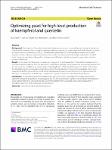Item Infomation
Full metadata record
| DC Field | Value | Language |
|---|---|---|
| dc.contributor.author | Musa, Tartik | - |
| dc.contributor.author | Juan, Liu | - |
| dc.contributor.author | Marta Tous, Mohedano | - |
| dc.date.accessioned | 2023-04-21T01:27:30Z | - |
| dc.date.available | 2023-04-21T01:27:30Z | - |
| dc.date.issued | 2023 | - |
| dc.identifier.uri | https://link.springer.com/article/10.1186/s12934-023-02084-4 | - |
| dc.identifier.uri | https://dlib.phenikaa-uni.edu.vn/handle/PNK/8179 | - |
| dc.description | CC BY | vi |
| dc.description.abstract | Two important flavonoids, kaempferol and quercetin possess remarkably potent biological impacts on human health. However, their structural complexity and low abundance in nature make both bulk chemical synthesis and extraction from native plants difficult. Therefore microbial production via heterologous expression of plant enzymes can be a safe and sustainable route for their production. Despite several attempts reported in microbial hosts, the production levels of kaempferol and quercetin still stay far behind compared to many other microbial-produced flavonoids. | vi |
| dc.language.iso | en | vi |
| dc.publisher | Springer | vi |
| dc.subject | Optimizing yeast | vi |
| dc.subject | kaempferol and quercetin | vi |
| dc.title | Optimizing yeast for high-level production of kaempferol and quercetin | vi |
| dc.type | Book | vi |
| Appears in Collections | ||
| OER - Khoa học Tự nhiên | ||
Files in This Item:

